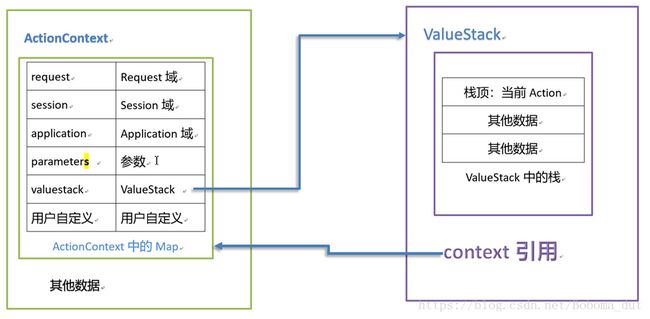Struts2的Ognl表达式的理解与使用
在Struts中,我们可以通过Ognl表达式操作ActionContext上下文和ValueStack栈中的数据。
表现形式为:
在Java代码中,我们可以使用第三方jar包的Ognl对象来操作ActionContext和ValueStack,
将ActionContext作为Ognl的上下文,将ValueStack的Root作为Ognl的根。
当然,Struts默认就是通过这种方式访问上下文和Stack栈的。
在页面Jsp中,我们可以使用s标签库通过Ognl表达式的格式来访问这些数据。
ActionContext与ValueStack的关系图如下:

需要注意的是,ValueStack中对上下文的引用,不是直接引用的ActionContext对象,而是上下文对象中具体存储数据的那个Map。
Ognl操作理解:
1、理解Ognl概念
Ognl,Object Graphic Navigation Language,对象图导航语言
意思就是每个对象都能根据其内部是属性和属性的嵌套,来生成一个该对象的对象图:
例如:
有地址类Address:
public class Address {
private String province;
private String city;
private String detail;
private boolean def;
//省略getter/setter
}有学校类School,关联地址类:
public class School {
private String name;
private Address addr;
//省略getter/setter方法
}
那么对于Address,它的对象图导航就是:
Address
--provice --city --detail --defSchool的对象图导航:
School
--name --addr --province --city --detail --defOgnl表达式就是根据这种对象图导航的方式,来便捷的访问到类对象的属性,从而操作属性值。
比如,要访问school对象的详细地址,那表达式就是 “addr.detail”。
其实在之前的EL表达式中,我们也是使用这种方式来访问对象内容的(只是我们没拿出这个概念来说)
2、通过Ognl表达式访问数据
根据数据在不同的地方,Ognl表达式的写法不同,如果数据在上下文ActionContext的Map中,那么表达式要以#开头,如果在ValueStack中,那么可以直接写表达式。
例如,在Java中使用Ognl对象,访问ActionConext中 或 ValueStack中的name参数
访问ActionContext:
String s1 = (String) Ognl.getValue(“#name”, vs.getContext(), vs.getRoot());
访问ValueStack:
String s1 = (String) Ognl.getValue(“name”, vs.getContext(), vs.getRoot());
3、调用ValueStack的set(“名”,”值”),会向ValueStack栈中压入一个Map,Map中的数据就是新添加的键值对
4、我们可以操作ValueStack对象,比如向栈中添加数据等,但是我们一般不这么做,在页面与Action之间传参,我们一般通过上下文来操作。
5、[N]语法
Ognl表达式中的[N]语法,根据其根数据的类型不同,展现出不同的结果。
如果根数据是栈,比如ValueStack中的Root栈,那么[N]语法会返回一个集合,集合内容为从第N个元素开始一直到栈底的数据。
例如:
Ognl.getValue("[1].username",vs.getContext(), vs.getRoot());
表示,跳过栈顶元素,从第二个元素开始,寻找对象的username属性的值。而不是就找第二个元素的username属性。
如果我们就要瞄准栈中的第几个元素,那么就要使用[N].top,也就是需要结合top关键字。
如果根的数据类型是数组/有序集合,那么[N]语法就会返回数组或集合中的第几个元素。
例如:
List<Adrress> list= new ArrayList();
//省略数据的充填
Ognl表达式:
Ognl.getValue("[1].province",vs.getContext(), list);
表示获取第二个Address对象的省份信息这两中不同的展现是由于类的内部对下标的实现逻辑有区别。
6、上下文中的域 与 requst对象中的域
向域中添加参数name,值为“Jack”,可以有以下两种方式:
1)
Map req = ActionContext.getContext().get(“request”);
req.put(“name”,”Jack”);
2)
HttpServletRequest req = ServletActionContext.getRequest();
req.setAttribute(“name”,”Jack”);
第一种方法是通过上下文获取、操作Request域,第二种方式是获取Request对象,然后自己操作对象的域,这两种方式都可以实现我们的目的。
但是我们要讨论的是,Request对象中的域 和 ActionContext上下文中的request域是同一个对象吗,可以混用吗??
显然,他们不是同一个Map,至于使用,我们可以看一下代码:
ValueStack vs = ActionContext.getContext().getValueStack();
HttpServletRequest req = ServletActionContext.getRequest();
//通过request对象添加域数据
req.setAttribute("name", "req-name");
req.setAttribute("name2", "req-name2");
req.setAttribute("name3", "req-name3");
//通过上下文中的request域模型,打印域中的数据
Map map = vs.getContext();
Map req_map = (Map) map.get("request");
System.out.println(req_map);
//{struts.actionMapping=ActionMapping@789778, name2=req-name2, name3=req-name3, name=req-name, struts.valueStack=com.opensymphony.xwork2.ognl.OgnlValueStack@3c9ff82c}
//发现上下文中的request域中有通过request对象添加的参数,即两者的内容目前一致
//接着第二次向request对象域中添加数据
req.setAttribute("name3", "req-name3-2");
//第二次打印上下文中的request域数据
System.out.println(req_map);
//{struts.actionMapping=ActionMapping@789778, name2=req-name2, name3=req-name3, name=req-name, struts.valueStack=com.opensymphony.xwork2.ognl.OgnlValueStack@3c9ff82c}
//发现上下文中的request域中的数据并没有更改,“name3”的值还是旧值“req-name3”
通过以上测试,我们发现request对象的域attrMap,与上下文中的request域,数据并不是实时同步一致的,所以,在应用中,我们不要要保证前后逻辑使用的域对象一致,不要混用。
在上面的实验中,如果接着向上下文的request域中添加/删除数据,你会发现两个域中的数据又会同步,变为相同。这其中的逻辑可以看一下Struts中关于上下文中request域对象的实现源码:org.apache.struts2.dispatcher.RequestMap
7、#request.name能访问的数据的范围
先说结论:
会先查找request域中是否有name参数,然后查找ValueStack(Root栈中是否有对象具有name属性),然后查找ActionContext的Map中,是否有Key为name的键值对。
对于第一步查找request域,我们不会有任何疑问,那么为什么会有后面对ValueStack栈以及contextMap的查找呢?
这个还得回到根本问题上:request.name,到底调用了什么方法?
我们知道#号表示访问ActionContext上下文的Map,
#request 获取上下文中的request域,类型是Map,
#request.name,”.”点相当于调用 Map的get方法,即request.get(“name”)
上下文中的request域对象,是经过struts封装的一个Map,它的准确类型是RequestMap,
我们来看一下该对象:
public class RequestMap extends AbstractMap implements Serializable {
private static final long serialVersionUID = -7675640869293787926L;
private Setget方法的实现中,调用了request对象的getAtrribute方法,看起来貌似没有什么问题,但是此处的request也不是我们之前认识的那个request对象,而是Struts又一次封装的对象,其类型为:StrutsRequestWrapper,我们看一下该对象的getAttribute方法的实现:
/** * Gets the object, looking in the value stack if not found !!!!注意 * * @param key The attribute key */
public Object getAttribute(String key) {
if (key == null) {
throw new NullPointerException("You must specify a key value");
}
if (disableRequestAttributeValueStackLookup || key.startsWith("javax.servlet")) {
// don't bother with the standard javax.servlet attributes, we can short-circuit this
// see WW-953 and the forums post linked in that issue for more info
return super.getAttribute(key);
}
ActionContext ctx = ActionContext.getContext();
Object attribute = super.getAttribute(key);!!!!注意
if (ctx != null && attribute == null) {!!!!注意
boolean alreadyIn = isTrue((Boolean) ctx.get(REQUEST_WRAPPER_GET_ATTRIBUTE));
// note: we don't let # come through or else a request for
// #attr.foo or #request.foo could cause an endless loop
if (!alreadyIn && !key.contains("#")) {
try {
// If not found, then try the ValueStack
ctx.put(REQUEST_WRAPPER_GET_ATTRIBUTE, Boolean.TRUE);
ValueStack stack = ctx.getValueStack();
if (stack != null) {
attribute = stack.findValue(key);!!!!注意
}
} finally {
ctx.put(REQUEST_WRAPPER_GET_ATTRIBUTE, Boolean.FALSE);
}
}
}
return attribute;
}
注意一下,我做“!!!”符号标记的地方,该类的getAttribute方法重写了父类的方法,修改了查找逻辑。当在本对象中找不到时,会调用valuestack的findValue方法(该方法会查找栈和contextMap)。
通过源代码,我们就明白为什么#request.name的查找范围会那么广!
同样,在Struts的jsp页面中使用EL表达式${name},也会依次查找request本域、valuestack栈、contextMap,其背后的原因也是EL表达式默认调用request对象的getAttribute方法。